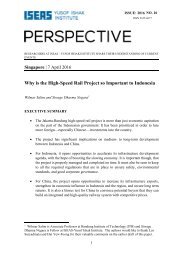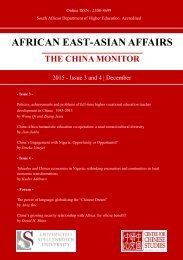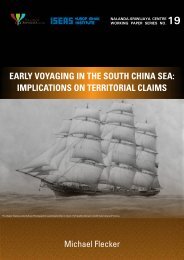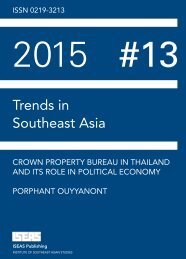Create successful ePaper yourself
Turn your PDF publications into a flip-book with our unique Google optimized e-Paper software.
subsequent communication with <strong>the</strong> Com<strong>in</strong>tern to mail alone. In around 1934, <strong>the</strong>ir connections<br />
were to some extent restored and n<strong>in</strong>e representatives were successively dispatched to Shanghai. In<br />
1935 and 1936 also, a few were sent aga<strong>in</strong>. Yet, it w<strong>as</strong> difficult for <strong>the</strong>m to contact ei<strong>the</strong>r <strong>the</strong><br />
Com<strong>in</strong>tern or <strong>the</strong> CCP. As for representatives sent to <strong>the</strong> Com<strong>in</strong>tern’s Headquarters, Moscow, only<br />
two persons could be confirmed. One w<strong>as</strong> Fu Hung-chi who came back to Shanghai from Moscow<br />
towards <strong>the</strong> end of 1930 and an unknown person who w<strong>as</strong> dispatched to Moscow to attend <strong>the</strong> 7th<br />
World Congress <strong>in</strong> 1934. <strong>The</strong>refore, <strong>the</strong>re might be no direct connection between <strong>the</strong> Com<strong>in</strong>tern<br />
and <strong>the</strong> MCP.<br />
6. Documents analyzed here ranged from 1928 until early 1942. Divid<strong>in</strong>g <strong>the</strong>se <strong>in</strong>to two,<br />
documents written by <strong>the</strong> Com<strong>in</strong>tern and those by <strong>the</strong> MCP, <strong>the</strong> important ones are shown by<br />
chronological order <strong>in</strong> Table 6. Those written by <strong>the</strong> Com<strong>in</strong>tern, most of <strong>the</strong>m seemed to have been<br />
sent from Shanghai, could not necessarily reach <strong>the</strong> MCP <strong>in</strong> Malaya (mostly S<strong>in</strong>gapore). Those<br />
written by <strong>the</strong> MCP certa<strong>in</strong>ly reached <strong>the</strong> Com<strong>in</strong>tern simply because <strong>the</strong>se were kept <strong>in</strong> <strong>the</strong>ir<br />
archives. But some were <strong>in</strong>tercepted ei<strong>the</strong>r <strong>in</strong> Malaya or <strong>in</strong> Shanghai and could not reach <strong>the</strong><br />
Com<strong>in</strong>tern. <strong>The</strong>se were not listed <strong>in</strong> <strong>the</strong> Com<strong>in</strong>tern <strong>Files</strong>.<br />
From immediately before <strong>the</strong> foundation of <strong>the</strong> MCP <strong>in</strong> early 1930 until <strong>the</strong> arrests of <strong>the</strong><br />
Ducroux group <strong>in</strong> mid-1931, many letters were exchanged. <strong>The</strong>re existed “dialogue”, that is,<br />
someth<strong>in</strong>g like; report ~ <strong>in</strong>struction ~ reply ~ comment~ criticism. This dialogue w<strong>as</strong> stopped by<br />
<strong>the</strong> Ducroux <strong>in</strong>cident. As for 1932, only one MCP’s letter written towards <strong>the</strong> end of that year<br />
reached Moscow. Two MCP letters written <strong>in</strong> 1933 took a year to reach <strong>the</strong> Com<strong>in</strong>tern. In 1934,<br />
communication w<strong>as</strong> revived. Yet, a majority of <strong>the</strong> MCP letters appeared not to reach <strong>the</strong><br />
Com<strong>in</strong>tern due to <strong>in</strong>terception of <strong>the</strong> SB. As far <strong>as</strong> <strong>the</strong> documents listed on <strong>the</strong> Com<strong>in</strong>tern <strong>Files</strong>, an<br />
<strong>in</strong>struction sent from <strong>the</strong> AAS dated 25 January 1935 w<strong>as</strong> <strong>the</strong> l<strong>as</strong>t one sent to <strong>the</strong> MCP. After that,<br />
no such directive w<strong>as</strong> recorded among <strong>the</strong> Com<strong>in</strong>tern <strong>Files</strong>.<br />
Accord<strong>in</strong>g to Yong, <strong>the</strong> MCP’s adoption of <strong>the</strong> m<strong>as</strong>s l<strong>in</strong>e [Anti-Japanese United Front] <strong>in</strong><br />
1936 w<strong>as</strong> <strong>in</strong> response first to Com<strong>in</strong>tern directive aris<strong>in</strong>g from its Seventh World Congress <strong>in</strong><br />
Moscow <strong>in</strong> July 1935 and <strong>the</strong>n to <strong>the</strong> CCP advice after <strong>the</strong> Sian [Xian] Incident <strong>in</strong> December<br />
1936. 1 It is well recorded <strong>in</strong> his book that <strong>in</strong> this period <strong>the</strong> CCP <strong>in</strong>cre<strong>as</strong>ed its <strong>in</strong>fluence over <strong>the</strong><br />
MCP, especially by send<strong>in</strong>g many tra<strong>in</strong>ed cadres to Malaya to lead <strong>the</strong> anti-Japanese movement. 2<br />
No <strong>in</strong>struction after that w<strong>as</strong> mentioned <strong>in</strong> his book. Cheah, too, said: “<strong>The</strong> MCP rema<strong>in</strong>ed<br />
throughout of <strong>the</strong> year [1936] isolated from contact with <strong>the</strong> Com<strong>in</strong>tern”. 3 No directive after 1936<br />
w<strong>as</strong> referred <strong>in</strong> his book. McLane also wrote: “Ties alleged to have existed s<strong>in</strong>ce 1933 between <strong>the</strong><br />
130








